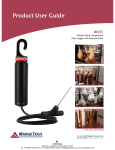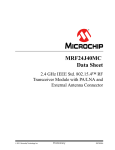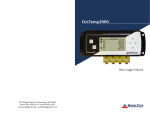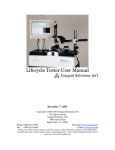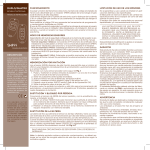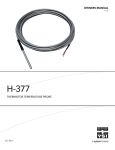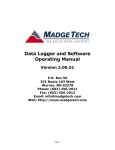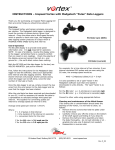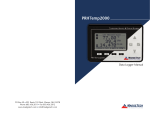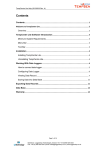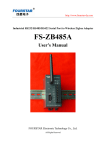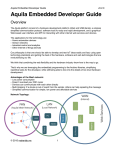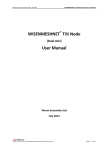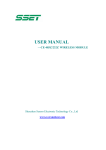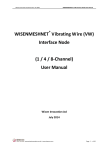Download User Manual - Data Loggers
Transcript
Product User Guide RFCurrent2000A RFCurrent2000A Wireless Current Data Logger Distributor: LoggerShop Technologies | Dorset Tel: +44 (0)845 520 0202 Fax: +44 (0)845 520 0203 | Email: [email protected] | www.loggershop.co.uk Product User Guide Table of Contents RFCurrent2000A Data Logger Quick Start Steps ............................................ 1 Product Overview ........................................... 2 Additional Features & Operation ..................... 3 Mounting Instructions .................................... 4 Product Maintenance...................................... 5 Recalibration ................................................... 5 RMA Instructions.............................................. 5 General Specifications................................... 6-7 RFC1000 Transceiver Product Overview ........................................... 9 Installation Guide ............................................ 9 Mounting Instruction .................................... 10 Channel Programming.................................. 11 Deployment & Activation............................... 12 General Specifications.................................... 12 Compliance Information................................. 13 Troubleshooting Tips ............. Back Cover Distributor: LoggerShop Technologies | Dorset Tel: +44 (0)845 520 0202 Fax: +44 (0)845 520 0203 | Email: [email protected] | www.loggershop.co.uk Quick Start Steps Product Operation (Wireless) 1. Install the MadgeTech 4 Software and USB Drivers onto a Windows PC. 2. The RFC1000 interface device comes with a USB cable. Plug one end of the cable into an available USB port on the PC and plug the opposite end of the cable into the communication port on the RFC1000. 3. Push and hold the wireless button on the RFCurrent2000A for 5 seconds to activate wireless communication. The display will confirm “Wireless: ON” and the blue LED will blink every 15 seconds. 4. Launch the MadgeTech 4 Software. All active MadgeTech Data Loggers that are within range will automatically appear in the connected devices window. Each data logger in the list can be identified by serial number (printed on the exterior of the logger). 5. To claim a device, select the desired data logger in the list and click the Claim icon. 6. Select the start method, reading rate and any other parameters appropriate for the desired data logging application. Once configured, deploy the data logger by clicking the Start icon. 7. To download data, select the device in the list, click the Stop icon, and then click the Download icon. A graph will automatically display the data. Product Operation (Plugged In) 1. Install the MadgeTech 4 Software and USB Drivers onto a Windows PC. 2. Before plugging the data logger in the computer, make sure the wireless setting on the device is set to “Wireless: OFF”. If wireless mode is on, press and hold the Wireless button on the device for 5 seconds. 3. The RFCurrent2000A comes with a USB cable. Plug one end of the cable into an available USB port on the PC and plug the opposite end of the cable into the communication port on the RFCurrent2000A. 4. Launch the Data Logger Software. The RFCurrent2000A will appear in the connected devices window indicating the device has been recognized. 5. Select the start method, reading rate and any other parameters appropriate for the desired data logging application. Once configured, deploy the data logger by clicking the Start icon. 6. To download data, select the device in the list, click the Stop icon, and then click the Download icon. A graph will automatically display the data. 1 Distributor: LoggerShop Technologies | Dorset Tel: +44 (0)845 520 0202 Fax: +44 (0)845 520 0203 | Email: [email protected] | www.loggershop.co.uk Product User Guide Product Overview The RFCurrent2000A is a wireless data logger with display, designed to measure and record DC current signals. The data logger can connect directly to low-level DC current sources which makes it ideal for battery usage studies, energy monitoring studies and other DC current monitoring applications. The RFCurrent2000A can also be interfaced with a wide range of current output sensors such as flow meters, pH transmitters and more. Through the software, the device can be programmed with engineering units, which convert the current readings into a different unit of measure such as flow rate. The engineering unit is available for display on the LCD screen as well as in the software. The RFCurrent2000A is available in 20mA, 160mA or a 3A measurement range. The RFCurrent2000A features an LCD screen which provides instant access to the current reading, minimum, maximum and average statistics. The statistics can be reset through the keypad of the device, allowing customers to keep track of statistics over certain time periods. This feature does not erase the data recorded, but only resets the statistics count. The RFCurrent2000A can be used as a standalone data logger, or used with the RFC1000 wireless transceiver, to transmit data back to a central PC. The RFCurrent2000A transmits up to 500’ line of sight to the RFC1000 transceiver. Multiple RFC1000’s can be used as repeaters and transmit up to 1000’ line of sight to other RFC1000’s. This allows the data to be sent over a greater distance. Selection Buttons The logger is designed with 3 direct selection buttons: Scroll, Units and Wireless. • Scroll: Allows user to scroll through current readings, average stats and device status information displayed on the LCD Screen. • Units: Allows user to change displayed units of measurement, A and mA Engineering Units. • Wireless: Push and hold this button for 5 seconds to activate or deactivate wireless communication. • Manual Reset Option: Allows user to manually reset the statistics within the device to 0 without needing to use the Data Logging software. Any data recorded up to that point is recorded and saved. LED Indicators • Status: Green LED blinks every 5 seconds to indicate unit is logging. • Wireless: Blue LED blinks every 15 seconds to indicate unit is operating in wireless mode. • Alarm: Red LED blinks every 1 second to indicate an alarm condition. Connecting Information Port Information The RFCurrent2000A data logger terminal ports are located on the bottom of the device, one positive, one negative and a ground terminal port. GND 2 Distributor: LoggerShop Technologies | Dorset Tel: +44 (0)845 520 0202 Fax: +44 (0)845 520 0203 | Email: [email protected] | www.loggershop.co.uk RFCurrent2000A Additional Features and Operation Alarm Settings/Rules In the Data Logging Software, alarms can be created on two levels; in the software itself, and programmed specifically to the data logger. Creating alarm rules in the software allows the user to utilize alarms while real time recording, and have the added benefit of features such as e-mail and SMS notification. An alarm that is programmed on the data logger will only alert the user from the device itself, whether that is by a flashing LED, audible alarm, or local LCD notification. Creating a Real time Alarm Rule 1. Within the Device tab in the Data Logging Software, in the Alarms group, click Manage Rules, then select New. 2. Enter a name in the Rule name box, and select whether notifications will occur when All conditions are met or Any condition is met. 3. Select the desired conditions to have met before notifications occur, and select which notifications will occur from the drop down menus. 4. If selecting to receive notifications by email or text message, click Email settings and make sure the correct info has been entered. Email and text message notifications will not be received if settings are incorrect. 5. Click OK. The OK button will be disabled if the Rule name box is empty. Changing the Alarm Settings of a Device 1.In the Connected devices panel, select the RFCurrent2000A device. 2.Click the Properties button under the device tab at the top of the software, and select the Alarm tab in the Properties window. 3.The High and Low settings indicate reading thresholds at which the alarm becomes active. 4.The Delay setting indicates how long to wait before the alarm becomes active after passing an alarm threshold. 5.The Use cumulative alarm delay checkbox indicates whether the alarm delay should reset when reading values fall back within the alarm threshold. 6.Once the alarm is configured appropriately, click Apply to save the settings. 3 Distributor: LoggerShop Technologies | Dorset Tel: +44 (0)845 520 0202 Fax: +44 (0)845 520 0203 | Email: [email protected] | www.loggershop.co.uk Product User Guide Mounting Instructions The base provided with the RFCurrent2000A can be used in two ways. • The bottom of the logger snaps in place to use and mount the unit on a table top or horizontal surface. • The base can also securely snap to the backside of the logger for wall mounting if desired (as shown below). • There are two holes in the base to allow for screws for mounting. 4 Distributor: LoggerShop Technologies | Dorset Tel: +44 (0)845 520 0202 Fax: +44 (0)845 520 0203 | Email: [email protected] | www.loggershop.co.uk RFCurrent2000A Product Maintenance Battery Replacement Materials: U9VL-J Battery 1. On the bottom of the enclosure, open the battery compartment by pulling in on the cover tab. 2. Remove the battery by pulling it from the compartment. 3. Install the new battery, taking note of the polarity. 4. Push the cover closed until it clicks. Recalibration Standard recalibration for the RFCurrent2000A-3A are two points, 0A and 1.00A. For the RFCurrent2000A-20mA, the standard calibration points are 0mA and 25V. For the RFCurrent2000A-160mA the standard calibration points are 0mA and 100mA. Recalibration is recommended annually for any data logger; a reminder is automatically displayed in the software when the device is due. 5 Distributor: LoggerShop Technologies | Dorset Tel: +44 (0)845 520 0202 Fax: +44 (0)845 520 0203 | Email: [email protected] | www.loggershop.co.uk Product User Guide RFCurrent2000A General Specifications Reading Rate Memory Memory Wrap Around 1 reading every second up to 1 reading every 24 hours 32,256 readings Yes Start Modes Immediate Start & Delayed Start Stop Modes • Manual through software • Delayed Stop • Timed (specific date and time) Real Time Recording The device may be used with PC to monitor and record data in real-time User configurable audible, on-screen, email and text (SMS) alarms. Alarm Audible Alarm Functionality Alarm Delay: A cumulative alarm delay may be set in which the device will activate the alarm (via LED) only when the device has recorded a user specified time duration of data. 1 beep per second for reading alarm above/below threshold LED Functionality • Green LED blinks every 10 seconds to indicate unit is logging • Blue LED blinks every 30 seconds to indicate unit is in wireless mode • Red LED blinks every 1 second to indicate alarm condition Password Protection An optional password may be programmed into the device to restrict access to configuration options. Data may be read out without the password. Engineering Units Native measurement units can be scaled to display measurement units of another type. This is useful when monitoring voltage outputs from different types of sensors such as temperature, CO2, flow rate and more. Calibration Calibration Date Battery Type Battery Life Data Format Time Accuracy Computer Interface Software Operating Environment Dimensions Weight Enclosure Material Approvals Digital Calibration through software. Automatically recorded through the device Ultralife 9V Lithium included; user replaceable Approximately 4 years typical for 15 minute reading rate uA, mA, A ± 1 minute/month USB to mini USB, 250,000 baud for standalone operation or RFC1000/ RFC1000-CE/RFC1000-IP69K required for wireless operation XP SP3/Vista/Windows 7/Windows 8 (MadgeTech 4 only) -20°C to +60°C (-4°F to +140°F) 0% to 95% RH non-condensing 3.3” x 3.5” x 0.95” (82.6mm x 88.9mm x 24.1mm) - Data logger only 4.1 oz (0.2563 lbs) ABS Plastic US (FCC), CA (IC), CE, South Korea (KCC) This device complies with Part 15 of the FCC Rules. Operation is subject to the following two conditions: (1) this device may not cause harmful interference, and (2) this device must accept any interference received, including interference that may cause undesired operation. 6 To satisfy FCC RF Exposure requirements for mobile and base station transmission devices, a separation distance of 20 cm or more should be maintained between the antenna of this device and persons during operation. To ensure compliance, operation at closer than this distance is not recommended. The antenna(s) used for this transmitter must not be co-located or operating in conjunction with any other antenna or transmitter. Distributor: LoggerShop Technologies | Dorset Tel: +44 (0)845 520 0202 Fax: +44 (0)845 520 0203 | Email: [email protected] | www.loggershop.co.uk RFCurrent2000A Measurement Sensor Type Current Sensing Circuitry 20mA 160mA 3A -2mA to +30mA -160mA to +160mA -3A to +3A 2.5 V 2.5 V 2.5 V 0.0005mA for 20mA 0.01mA for 160mA 0.0001A for 3A ±0.0025mA ±0.01mA ±0.0001A 10 Ω 1Ω 0.02 Ω ±232 mA for 2 Seconds ±707 mA for 2 Seconds ±5A for 2 Seconds Nominal Range Measurement Range Maximum Voltage Between Inputs to Ground Measurement Resolution Calibrated Accuracy Input Impedance Absolute Maximum Current Input Connection Analog Conversion Time Frequency Rejection Temperature Coefficient Response Time Terminal Ports: one positive, one negative and a ground terminal port. 150 mS 50+60 Hz < ± 50 ppm/°C typical 0.15 Seconds at Sensor Wireless RF Frequency Band Receiver Sensitivity (RFC1000) 2.45GHz IEEE 802.15.4 ultra-low power wireless transceiver with fully bi-directional communication ISM band 2.405-2.475 GHz Operation (channels 11 through 25) @ 250 kbps -95dBm typical • Transmission Distance (to other RFC1000’s) • • Transmission Distance (to data loggers) • RFC1000 4,000’ max. outdoors - line of sight unobstructed 1,000’ max. indoors - typical urban environment RFC1000-CE 2,500’ max. outdoors - line of sight unobstructed 700’ max. indoors - typical urban environment RFC1000-IP69K 4,000’ max. outdoors - line of sight unobstructed 1,000’ max. indoors - typical urban environment RFC1000, RFC1000-CE & RFC1000-IP69K 2,000’ max. outdoors - line of sight unobstructed 500’ max. indoors - typical urban environment Battery Warning WARNING: MAY LEAK, FLAME OR EXPLODE IF DISASSEMBLED, SHORTED, CHARGED, CONNECTED TOGETHER, MIXED WITH USED OR OTHER BATTERIES, AND/OR EXPOSED TO FIRE/HIGH TEMPERATURE. DISCARD USED BATTERY PROMPTLY, KEEP OUT OF REACH OF CHILDREN. Specifications subject to change. 7 Distributor: LoggerShop Technologies | Dorset Tel: +44 (0)845 520 0202 Fax: +44 (0)845 520 0203 | Email: [email protected] | www.loggershop.co.uk Product User Guide RFC1000 Wireless Transceiver 8 Distributor: LoggerShop Technologies | Dorset Tel: +44 (0)845 520 0202 Fax: +44 (0)845 520 0203 | Email: [email protected] | www.loggershop.co.uk RFC1000 Product Overview The RFC1000 is a high powered transceiver that has a substantially long transmission range, providing enhanced performance in occluded environments (ovens, refrigerators, etc.). The RFC1000 also features an external antenna, allowing more flexibility with mounting positions in both orientation and proximity to metal walls. The device may be used as a repeater, or directly plugged into the Windows PC. Transmission Distance The RFC1000 transmits to other RFC1000s up to 4000 feet maximum typical outdoors/ line of sight, 1000 feet maximum typical indoors/urban. The RFC1000 transmits to data loggers up to 2000 feet maximum typical outdoors/line of sight, 500 feet maximum typical indoors/urban. The RFC1000 can connect to a maximum of 64 data loggers. The RFC1000 transmits on a frequency of 2.405GHz - 2.475 GHz. Operating Environment The RFC1000 is rated for use in an environment with temperatures from -20°C to 85°C and a humidity range of 0% to 95% RH non-condensing. The RFC1000 is rated IP40 and is protected against solids that are greater than 1mm in size. This device is not water resistant. LEDs The red LED indicates that the device has power. The green LED will blink when communicating with other devices. Installation Guide Installing the MadgeTech 4 Software Insert the Data Logger Software Flash Drive into an open USB port on a Windows PC. If the autorun does not appear, locate the drive on the computer and double click on Autorun. exe. Follow the instructions provided in the Installation Wizard. 1. Locate the Autorun.exe file on the Software Flash Drive. 2. Select “Data Logger Software” in the Installer Options window panel. 3. If the Windows PC doesn’t already have .NET 4.0 Framework, installation may be required. Note: To see if the .NET 4.0 Framework is installed, go to the Windows Control Panel and select Programs. “Microsoft .NET Framework 4.0” would be listed as a Windows program. Select “Install Data Logger Software” if .NET framework is installed on the Windows PC, or if installing on a Windows 8 machine. 9 Distributor: LoggerShop Technologies | Dorset Tel: +44 (0)845 520 0202 Fax: +44 (0)845 520 0203 | Email: [email protected] | www.loggershop.co.uk Product User Guide Mounting Instructions For best wireless performance, both the RFC1000 and the data loggers should be mounted in the same orientation. This usually means that the external antenna should be pointing straight up. The antenna can pivot to accommodate either a wall mount or a desk mount. 10 Distributor: LoggerShop Technologies | Dorset Tel: +44 (0)845 520 0202 Fax: +44 (0)845 520 0203 | Email: [email protected] | www.loggershop.co.uk RFC1000 Channel Programming The RFC1000 transmits data on the 2.4GHz band and is programmed by default on channel 11. Each wireless Data Logger and RFC1000 has a set of dip switches with which the channel may be programmed. Different wireless channels may be used to create multiple networks in one area, or to avoid wireless interference from other devices. Any data logger or RFC1000 that is on the same network is required to use the same channel. If all of the devices are not on the same channel, the devices will not communicate with one another. The images below show the orientations available of the switches for each channel. Channel 26 (all switches in the up position) is not supported. Channel 11 Channel 17 Channel 12 Channel 18 Channel 23 Channel 13 Channel 19 Channel 24 Channel 14 Channel 20 Channel 25 Channel 15 Channel 21 Channel 16 Channel 22 Channel 26 (not supported) Follow the instructions below to configure the channel settings of the RFC1000 1. To program the channel on an RFC1000, first unplug the RFC1000. 2. Use a Phillips head screwdriver to unscrew the enclosure. 3. Find the dip switches located on the front of the PCB circuit board. 4. Change the dip switches to match the the desired channel using the diagram above. 5. Screw the enclosure back together and reconnect the RFC1000. Close-up 11 Distributor: LoggerShop Technologies | Dorset Tel: +44 (0)845 520 0202 Fax: +44 (0)845 520 0203 | Email: [email protected] | www.loggershop.co.uk Product User Guide RFCurrent2000A: To program the channel on the RFCurrent2000A data logger, start by switching the wireless mode to OFF by holding down the Wireless button on the data logger for 5 seconds. Step 1: Use the USB Cable, plug the USB end of the cable into an available USB port on the PC. Step 2: Plug the opposite end of the cable into the communication port on the RFCurrent2000A. Step 3: Open the Data Logger Software. Locate and select the RFCurrent2000A in the Connected Devices panel. Step 4: In the Device tab, click the Properties icon. The Properties screen will display information about the device including Wireless setting. Step 5: Under the Wireless tab, select a desired channel (11-25) that will match with the RFC1000. Save all changes, disconnect the data logger, and return the device to wireless mode by holding down the Wireless button for 5 seconds. Deploying and Activating Devices Step 1: Plug the RFC1000 into the USB port on the base station computer. (Additional RFC1000s can be used as repeaters to transmit over greater distances) Step 2: If using multiple RFC1000s plug each one into a wall outlet in the desired locations. (If transmitting over a distance greater than 1000 feet indoors or 4000 feet outdoors or there are walls/obstacles/corners that need to be maneuvered around, set up additional RFC1000s as needed.) Step 3: Verify that the data loggers are in wireless transmission mode. (See Channel Programming steps above) Step 4: On a Windows PC, launch the Data Logger Software program. All active data loggers will be listed in the software showing that the device(s) are recognized. Step 5: To activate the data loggers, click on one to highlight, then click the Claim icon, and then click the Start button. Do this for each logger in the list that needs to be activate. RFC1000 General Specifications Interface Type Operating Environment LED Indicators Enclosure Materials Dimensions Approvals USB (to PC) / Wireless (to Data Logger) -20°C to +85°C, 0 to 95%RH non-condensing Red & Green ABS Plastic (body), PVC Plastic (antenna) Enclosure: 3.8” x 1.6” x 0.8” / Antenna: 7.2” FCC ID:OA3MRF24J40MC, IC#: 7693A-24J40MC Transmission Distance (To other RFC1000s) 4000’ max. outdoor - line of sight unobstructed 1000’ max. indoors - typical urban environment Transmission Distance (To data loggers) 2000’ max. outdoor - line of sight unobstructed 500’ max. indoors - typical urban Maximum number of connected data loggers Frequency Ingress Protection 64 2.405GHz - 2.475GHz IP40 12 Distributor: LoggerShop Technologies | Dorset Tel: +44 (0)845 520 0202 Fax: +44 (0)845 520 0203 | Email: [email protected] | www.loggershop.co.uk RFC1000 Compliance Information • “This device complies with Part 15 of the FCC Rules. Operation is subject to the following two conditions: (1) this device may not cause harmful interference, and (2) this device must accept any interference received, including interference that may cause undesired operation.” • “To satisfy FCC RF Exposure requirements for mobile and base station transmission devices, a separation distance of 20cm or more should be maintained between the antenna of this device and persons during operation. To ensure compliance, operation at closer than this distance is not recommended. The antenna(s) used for this transmitter must not be co-located or operating in conjunction with any other antenna or transmitter.” • “This device complies with Industry Canada license-exempt RSS standard(s). Operation is subject to the following two conditions: (1) this device may not cause interference, and (2) this device must accept any interference, including interference that may cause undesired operation of the device. Le présent appareil est conforme aux CNR d’Industrie Canada applicables aux appareils radio exempts de licence. L’exploitation est autorisée aux deux conditions suivantes: (1) l’appareil ne doit pas produire de brouillage, et (2) l’utilisateur de l’appareil doit accepter tout brouillage radioélectrique subi, même si le brouillage est susceptible d’en compromettre le fonctionnement.” • “Under Industry Canada regulations, this radio transmitter may only operate using an antenna of a type and maximum (or lesser) gain approved for the transmitter by Industry Canada. To reduce potential radio interference to other users, the antenna type and its gain should be so chosen that the equivalent isotropically radiated power (e.i.r.p.) is not more than that necessary for successful communication. Conformément à la réglementation d’Industrie Canada, le présent émetteur radio peut fonctionner avec une antenne d’un type et d’un gain maximal (ou inférieur) approuvé pour l’émetteur par Industrie Canada. Dans le but de réduire les risques de brouillage radioélectrique à l’intention des autres utilisateurs, il faut choisir le type d’antenne et son gain de sorte que la puissance isotrope rayonnée équivalente (p.i.r.e.) ne dépasse pas l’intensité nécessaire à l’établissement d’une communication satisfaisante.” 13 Distributor: LoggerShop Technologies | Dorset Tel: +44 (0)845 520 0202 Fax: +44 (0)845 520 0203 | Email: [email protected] | www.loggershop.co.uk Troubleshooting Tips Why is the wireless data logger not appearing in the software? If the RFCurrent2000A doesn’t appear in the Connected Devices panel, or an error message is received while using the RFCurrent2000A, try the following: • Check that the RFC1000 is properly connected. For more information, see Troubleshooting Interface Cable problems (below). • Ensure that the battery is not discharged. For best voltage accuracy, use a voltage meter connected to the battery of the device. If possible, try switching the battery with a new 9V lithium. • Ensure that no other software is running in the background. • Ensure that the most current data logger software is being used. • Ensure that the Connected Devices panel is large enough to display devices. This can be verified by positioning the cursor on the edge of the Connected Devices panel until the resize cursor appears, then dragging the edge of the panel to resize it. The screen layout may also be reset in the options menu by selecting File, Options, and scrolling to the bottom. Troubleshooting Interface Cable problems Check that the software properly recognizes the connected RFC1000 wireless transceiver. If the wireless data logger is not appearing in the Connected Devices list, it may be that the RFC1000 is not properly connected. 1. In the software, click the File button, then click Options. 2. In the Options window, click Communications. 3. The Detected Interfaces box will list all of the available communication interfaces. If the RFC1000 is listed here, then the software has correctly recognized and is ready to use it. Check that Windows recognizes the connected RFC1000 wireless transceiver. If the software does not recognize the RFC1000, there may be a problem with Windows or the USB drivers. 1. In Windows, click Start, right-click Computer and choose Properties or press Windows+Break as a keyboard shortcut. 2. Click Device Manager in the left hand column. 3. Double click Universal Serial Bus Controllers. 4. Look for an entry for Data logger Interface. 5. If the entry is present, and there are no warning messages or icons, then windows has correctly recognized the connected RFC1000. 6. If the entry is not present, or has an exclamation point icon next to it, the USB drivers may need to be installed. These are available on the software flash drive included with the RFC1000. Ensure that the USB end of the RFC1000 is securely connected to the computer. 1. Locate the USB-A plug of the RFC1000. 2. If the interface cable is connected to the PC, unplug it. Wait ten seconds. 3. Reconnect the cable to the PC. 4. Check to make sure that the red LED is lit, indicating a successful connection. MadgeTech, Inc. 6 Warner Road l Warner, NH 03278 Phone 603.456.2011 l Fax 603.456.2012 www.madgetech.com l [email protected] REV 1 2013.12.19 Distributor: LoggerShop Technologies | Dorset Tel: +44 (0)845 520 0202 Fax: +44 (0)845 520 0203 | Email: [email protected] | www.loggershop.co.uk






















